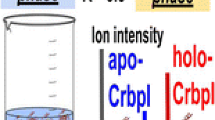Abstract
The retinoid affinity label 11[3H]-β-ionylidene ethylbromoacetate (IEBA) was covalently bound to plasma retinol-binding protein (RBP) and studies were conducted to identify the region of the protein molecule that contained the linkage between the IEBA ligand and RBP. Cleavage by trypsin and cyanogen bromide of the labeled protein followed by high-performance liquid chromatography (HPLC) separation of peptides and identification of radioactive peaks by amino acid analysis points to attachment of the ligand on tryptic peptides T(1+2) (containing residues 1–5) and T(21) (residues 156–163). These two peptides in the native protein molecule are connected by a disulfide bond between Cys-4 and Cys-160. To confirm the site of attachment of the radioactive ligand, unreduced IEBA-RBP with the disulfide bonds intact was treated first with cyanogen bromide and then with trypsin. Separation of the tryptic peptides by HPLC yielded one main peak of radioactivity containing both peptides T(1+2) and T(21), presumably connected by a disulfide bond. Taken together, these results indicated that the sites of attachment of IEBA to RBP are located within the region of the RBP molecule close to the Cys-4–Cys-160 bond, and specifically within the region comprised of amino acid residues 1–5 and 156–163.
Similar content being viewed by others
References
Erlanger, B. F., Vratsanos, S. M., Wassermann, N., and Cooper, A. G. (1996).Biochem. Biophys. Res. Commun. 23, 243–245.
Gawinowicz, M. A., and Goodman, D. S. (1982).Biochemistry 21, 1899–1905.
Goodman, D. S. (1984). InThe Retinoids, Vol. 2 (Sporn, M. B., Roberts, A. B., and Goodman, D. S., eds.), Academic Press, New York, pp. 41–88.
Goodman, D. S., and Raz, A. (1972).J. Lipid Res. 13, 338–347.
Harrison, E. H., Smith, J. E., and Goodman, D. S. (1980).Biochim. Biophys. Acta 628, 489–497.
Hass, G. M., and Neurath, H. (1971).Biochemistry 10, 3541–3546.
Horwitz, J., and Heller, J. (1973).J. Biol. Chem. 248, 6317–6324.
Kanai, M., Raz, A., and Goodman, D. S. (1968).J. Clin. Invest. 47, 2025–2044.
Kanda, Y., and Goodman, D. S. (1979).J. Lipid Res. 20, 865–878.
Lowry, O. H., Rosebrough, N. J., Farr, A. L., and Randall, R. J. (1951).J. Biol. Chem. 193, 265–275.
Muto, Y., Smith, J. E., Milch, P. O., and Goodman, D. S. (1972).J. Biol. Chem. 247, 2542–2550.
Newcomer, M. E., Jones, T. A., Åqvist, J., Sundelin, J., Eriksson, U., Rask, L., and Peterson, P. A. (1984).EMBO J. 3, 1451–1454.
Rask, L., Anundi, H., Böhme, H., Eriksson, U., Ronne, H., Sege, K., and Peterson, P. A. (1981),Ann. N. Y. Acad. Sci. 359, 79–90.
Rask, L., Valtersson, C., Anundi, H., Kvist, S., Eriksson, U., Dallner, G., and Peterson, P. A. (1983).Exp. Cell Res. 143, 91–102.
Smith, F. R., and Goodman, D. S. (1971).J. Clin. Invest. 50, 2456–2436.
Soprano, D. R., Smith, J. E., and Goodman, D. S. (1982).J. Biol. Chem. 257, 7693–7697.
Stein, S., and Moschera, J. (1981).Meth. Enzymol. 79, 7–16.
Visser, L., Sigman, D. S., and Blout, E. R. (1971).Biochemistry 10, 735–742.
Author information
Authors and Affiliations
Rights and permissions
About this article
Cite this article
Gawinowicz, M.A., Goodman, D.S. The site of linkage of a retinoid affinity label to plasma retinol-binding protein. J Protein Chem 4, 199–213 (1985). https://doi.org/10.1007/BF01025298
Received:
Published:
Issue Date:
DOI: https://doi.org/10.1007/BF01025298




